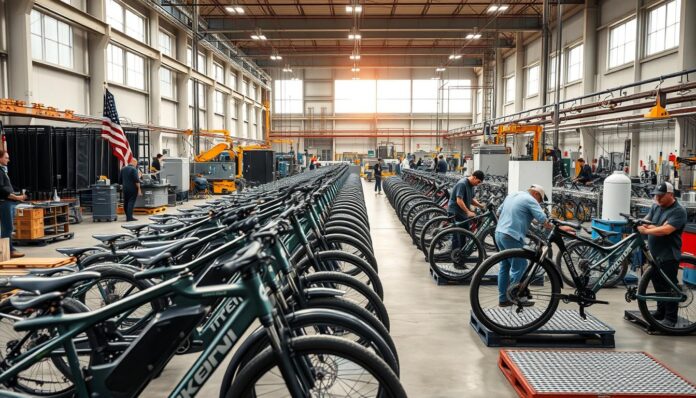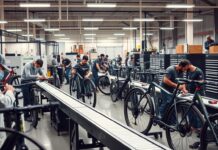Did you know China exported $3.83 billion worth of bicycles in 2022? The United States was the main buyer. This shows how much we rely on other countries for bikes at a key time for electric bicycles in America.
E-Bikes and parts made in the USA as tariffs loom the 25% tariff on these bikes could hurt our growing bike market. PeopleForBikes says this could make green travel harder for cities to adopt.
More people want american-made e-bikes. But what does “American-made” really mean? Are these bikes fully made here, or just put together with parts from other countries? We need to look closer at the global supply chain of domestic e-bike manufacturing.
There’s a big change happening in e-mobility made in America. Companies like those on ebikesus.com are facing both problems and chances. Knowing which parts are really made in America helps buyers choose the right buy American e-bikes.
Table of Contents
A Indepth Analysis of the impact of Tariffs on the e-bike industry.
Key Takeaways for E-Bikes and Parts Made in the USA as Tariffs Loom
- China exported $3.83 billion worth of bicycles to global markets in 2022, with the US as the primary destination
- A 25% tariff currently applies to electric bicycles, potentially slowing adoption of sustainable transportation
- The definition of “American-made” varies widely across the industry
- Global supply chains make true domestic manufacturing challenging
- Rising tariffs are creating both obstacles and opportunities for American manufacturing
- Consumers need transparency about where their e-bike components originate
Why is it such a big deal to try and make e-bikes in America?
It’s important to make e-bikes in America because of economic and strategic reasons. The push for domestic production is not just about being patriotic. It’s about dealing with rising import costs and supply chain problems.
Companies like those on ebikesus.com are leading the way. They’re navigating complex trade environments and building strong domestic production.
How do tariffs on Chinese goods affect the price of e-bikes?
Import tariffs have a big impact on e-bike prices. E-bikes from China now face a 25% tariff. Traditional bikes already have tariffs up to 36%.
This has already made e-bikes more expensive. The US is adding a new 20% tariff on Chinese imports starting March 4th, 2025. This will hit electric bikes hard.
E-bikes are a bright shining star right now. You see them everywhere, in every category, increasing market share across the board. But obviously, if we have additional tariffs, those prices are going to go up and will be another barrier to e-bikes.
These trade policies affect the supply chain a lot. When manufacturers pay tariffs, their profits drop. They often pass these costs to consumers, which can slow down e-bike adoption.
Can domestic manufacturing help avoid global supply chain disruptions?
The COVID-19 pandemic showed how vulnerable global supply chains are. In 2020, international shipping slowed down a lot. This left American retailers struggling to meet demand for electric bikes.
Domestic manufacturing is a good solution. It makes e-bikes closer to where they’re sold. This reduces shipping times and helps avoid international logistics problems.
Reshoring initiatives also help. They give companies more control over parts and production. This makes communication better and lead times shorter.
What are the economic benefits of creating e-bike manufacturing jobs in the US?
Building a domestic e-bike industry has big economic benefits. Manufacturing jobs pay more than retail or service jobs. They also create more jobs in related industries.
Domestic production helps local communities a lot. It supports businesses like suppliers and logistics providers. This strengthens regional economies and makes them more resilient.
Promoting local e-bike ecosystems also brings in tax revenue. Manufacturing facilities and employee income taxes support public services. Innovation in these clusters can attract more investment and talent.
| Economic Factor | Imported E-Bikes | US-Made E-Bikes | Community Impact |
|---|---|---|---|
| Job Creation | Limited to retail and service | Manufacturing, engineering, and support roles | Higher average wages and more diverse opportunities |
| Tax Revenue | Import duties and sales tax | Property, income, and corporate taxes | Broader tax base for community services |
| Economic Multiplier | Minimal local economic impact | Creates 2-3 additional jobs per manufacturing position | Strengthened local business ecosystem |
| Innovation Potentia | Limited knowledge transfer | Encourages R&D and technical advancement | Attracts skilled workforce and additional investment |
The impact of US production on quality control and safety standards
Domestic production lets companies see their processes clearly. This makes quality control better. Problems can be fixed right away, not after shipping.
American factories follow strict rules. These rules cover safety and the environment. This means products are safer and of better quality.
The tariff impact on e-bike industry also affects safety. Tariffs can make manufacturers cut corners. Domestic production helps avoid this by keeping an eye on safety-critical processes.
Being close to the market means American manufacturers can fix problems fast. They can update designs quickly. This is key for e-bikes, where safety is a big concern.
What makes it so hard for companies to build the entire e-bike in the USA?
Building e-bikes in America is tough, despite growing interest. It’s not just about making them. It’s about the complex supply chain and economic factors that have grown over years.
Where are most essential e-bike components like motors and batteries made?
Motors, batteries, and controllers mainly come from Asian countries. China leads, with Bosch (Germany) and Shimano (Japan) also big players. Many parts are not made in the USA, creating a big gap in the supply chain.
The challenge of building a domestic supply chain for e-bike parts from scratch
Bike Friday, which has made bikes in Oregon for 33 years, says: “Our bikes are only possible through a global supply chain.” Some bike parts have never been made in the USA. Creating a local e-bike supply chain needs special knowledge, equipment, and materials not found in the USA.
What is the cost difference of manufacturing labor in the US vs. Asia?
Labor costs in the USA are 5-10 times higher than in Asia. This makes usa e-bike parts suppliers struggle to compete with imports. Even with automation, the cost difference is big.
How much investment is needed to build an e-bike frame or battery factory?
An expert said: “It would take years and millions and millions of dollars to build such a thing that’s been built overseas over decades. It’s just not sustainable.” A new battery facility needs $100+ million, while frame manufacturing requires special equipment and knowledge.
Despite these challenges, companies on EBikesUS.com are moving forward. They’re using innovation and partnerships. These efforts are key steps toward a stronger domestic production, even if full independence is far off.






